Analysis of the goals of Fifa World Cup of Futsal in 2008
Abstract
Introduction: The Futsal is characterized by performing of tasks of attack and defense from the players that view to coordinate actions in order to recover, maintain, develop and create final situations with the objective of scoring a goal. Objective: The present study analyzed the goals that had occurred in the Fifa World Cup of Futsal in 2008. Quantify the tactical actions and verify from which place of the field occurred the goals. Materials and Methods: This sample was composed by 9 games from Fifas World Cup Futsal in 2008, in the cities of Brasília and Rio de Janeiro, between September 30th and October 19th , 2008. Results: We can realize that the most of the goals occurred from fast attacks and counterattacks that together represent 64.10 %. We can associate this dominance in the goals that were the results of the counterattacks being 38.46%. Discussion: Considering that the defenses tend to adopt a defensive style more active with the objective to recover fast the possession of the ball, the game gains in speed. Conclusion: We can find that the goals occur through the use of all offensive actions, being the counterattack and the fast attacks the most efficient ways to get the objective in the game, the goal. Being important to reinforce the defensive play in central area, where the incidence of the goals is larger.
References
- Ganef, E.; Reis, F. P. C.; Almeida, E. S.; Navarro, A. C. Influência do Goleiro-Linha no Resultado do jogo de Futsal. Revista Brasileira de Futsal e Futebol. São Paulo. Vol. 1. Num. 3. p. 186-192. 2009.
- Garganta, J. A análise da performance nos jogos desportivos: Revisão acerca da análise do jogo. Revista Portuguesa de Ciência do Desporto. Porto. Vol. 1. Num. 1. p. 57-64. 2001.
- Garganta, J. O treino da táctica e da técnica nos jogos desportivos à luz do compromisso cognição-acção. In Esporte e Actividade Física. Interacção entre rendimento e saúde. São Paulo. Editora Malone. p. 281-306. 2002.
- Garganta, J. Fundar os conceitos de estratégias e tática nos jogos desportivos colectivos, para promover uma eficácia superior. Revista Brasileira de Educação Física e Esporte. São Paulo. Vol. 20. Num. 5. p. 201-203. 2006.
- Garganta, J. Modelação táctica de jogo de Futebol: Estudo da organização da fase ofensiva em equipas de alto rendimento. Universidade do Porto Faculdade de Ciências do Desporto e de Educação Física. Dissertação de Doutorado. Porto. 1997.
- Leitão, R. A. A.; Moraes, A. C. Análise qualitativas e quantitativas para verificação e modulação de padrões e sistemas complexos de jogo. Dissertação de Mestrado em Ciências do Desporto - Faculdade de Educação Física. Universidade Estadual de Campinas. 2004.
- Oliveira, P. R. A.; Garganta, J. Amplitude e Profundidade dos Sistemas de jogo em Futsal. Universidade do Porto Faculdade de Ciências do Desporto e de Educação Física. Porto. 2008.
- Pessoa, V. L.; Silva, V. B. B.; Matias, C. J. A. S.; Greco, P. J. Análise dos gols da Liga Futsal 2008. Universidade Federal de Minas Gerais. Belo Horizonte. Disponível em http://www.efdeportes.com.
- Velásquez, A. C.; Ortega, J. P. Estúdio Praxiológico em el Fútbol de Alta Competción. Facultad de Ciências del Deporte. Universidad de Extremadura. Disponível em: http://www.efdeportes.com/efd20a/praxfut.htm. 2000.
Authors who publish in this journal agree to the following terms:
- Authors retain the copyright and grant the journal the right of first publication, with work simultaneously licensed under the Creative Commons Attribution License BY-NC which allows the sharing of the work with acknowledgment of the authorship of the work and initial publication in this journal.
- Authors are authorized to enter into additional contracts separately for non-exclusive distribution of the version of the work published in this journal (eg, publishing in institutional repository or book chapter), with acknowledgment of authorship and initial publication in this journal.
- Authors are allowed and encouraged to post and distribute their work online (eg, in institutional repositories or on their personal page) at any point before or during the editorial process, as this can bring about productive change as well as increase impact and impact. citation of published work (See The Effect of Free Access).





